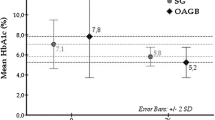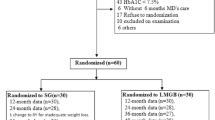Abstract
Background
This study aimed to compare the efficacy of laparoscopic sleeve gastrectomy (SG) with that of laparoscopic gastric bypass (GBP) and laparoscopic adjustable gastric banding (AGB) for glucose homeostasis in morbidly obese subjects with type 2 diabetes mellitus (T2DM) at a 3-year follow-up assessment and to elucidate the role of weight loss in the T2DM resolution after SG.
Methods
For this study, 60 morbidly obese T2DM patients (44 females and 16 males) who underwent AGB (24 patients), GBP (16 patients), or SG (20 patients) between 1996 and 2008 were retrospectively analyzed. Age, sex, body mass index (BMI), estimated weight loss (EWL), fasting glycemia, HbA1c, euglycemic hyperinsulinemic clamp, discontinuation of diabetes treatment, and time until interruption of therapy were evaluated.
Results
In the study, 54 patients received oral hypoglycemic agents for at least 12 months before surgery, and 6 patients received insulin. The mean follow-up period was 36 months. The resolution rate was 60.8% for the AGB patients, 81.2% for the GBP patients, and 80.9% for the SG patients. The postoperative time until interruption of therapy was 12.6 months for the AGB patients, 3.2 months for the GBP patients, and 3.3 months for the SG patients. The hyperinsulinemic euglycemic clamp test was performed 12 months after surgery for the cured patients. Insulin resistance was restored to normal values in all the patients. The greatest improvement from preoperative values occurred in the SG group. For the not-cured GBP and SG patients, an improvement of 120 mg/dl in fasting plasma glucose was observed 3 months after the surgery, suggesting an enhancement in insulin sensitivity, which determines better medical control. The resolution rate remained constant at the 36-month follow-up evaluation in both the GBP and SG groups.
Conclusions
All three bariatric procedures are effective in treating diabetes, with a 3-year follow-up evaluation showing an effect that lasts. The AGB procedure was the least effective. The antidiabetic effect was similarly precocious after GBP and SG compared with AGB. This difference may indicate that a hormonal mechanism may be involved, independent of weight loss.




Similar content being viewed by others
References
Buchwald H, Avidor Y, Braunwald E, Jensen MD, Pories W, Fahrbach K, Schoelles K (2004) Bariatric surgery: a systematic review and meta-analysis. JAMA 292:1724–1737
Elder KA, Wolfe BM (2007) Bariatric surgery: a review of procedures and outcomes. Gastroenterology 132:2253–2271
Deitel M, Crosby RD, Gagner M (2008) The first international consensus summit for Sleeve Gastrectomy (SG), New York City, October 25–27, 2007. Obes Surg 18:487–496
Regan JP, Inabnet WB, Gagner M, Pomp A (2003) Early experience with two-stage laparoscopic Roux-en-Y gastric bypass as an alternative in the super-super obese patient. Obes Surg 13:861–864
Karamanakos SN, Vagenas K, Kalfarentzos F, Alexandrides TK (2008) Weight loss, appetite suppression, and changes in fasting and postprandial ghrelin and peptide-YY levels after Roux-en-Y gastric bypass and sleeve gastrectomy: a prospective, double-blind study. Ann Surg 247:401–407
Lee CM, Cirangle PT, Jossart GH (2007) Vertical gastrectomy for morbid obesity in 216 patients: report of two-year results. Surg Endosc 21:1810–1816 Epub. 14 March 2007
Himpens J, Dapri G, Cadière GB (2006) A prospective randomized study between laparoscopic gastric banding and laparoscopic isolated sleeve gastrectomy: results after 1 and 3 years. Obes Surg 16:1450–1456
Cummings DE, Overduin J, Foster-Schubert KE (2004) Gastric bypass for obesity: mechanisms of weight loss and diabetes resolution. J Clin Endocrinol Metab 89:2608–2615
Schauer PR, Burguera B, Ikramuddin S, Cottam D, Gourash W, Hamad G, Eid GM, Mattar S, Ramanathan R, Barinas-Mitchel E, Rao RH, Kuller L, Kelley D (2003) Effect of laparoscopic Roux-en Y gastric bypass on type 2 diabetes mellitus. Ann Surg 238:467–484; discussion 84–85
Sugerman HJ, Wolfe LG, Sica DA, Clore JN (2003) Diabetes and hypertension in severe obesity and effects of gastric bypass-induced weight loss. Ann Surg 237:751–756
Sjöström CD, Lissner L, Wedel H, Sjöström L (1999) Reduction in incidence of diabetes, hypertension, and lipid disturbances after intentional weight loss induced by bariatric surgery: the SOS Intervention Study. Obes Res 7:477–484
Pories WJ, Mac Donald KG, Jr Morgan EJ, Sinha MK, Dohm GL, Swanson MS et al (1992) Surgical treatment of obesity and its effect on diabetes: 10-year follow-up. Am J Clin Nutr 55(2 Suppl):582S–585S
Hickey MS, Pories WJ, MacDonald KG Jr, Cory KA, Dohm GL, Swanson MS, Israel RG, Barakat HA, Considine RV, Caro JF, Houmard JA (1998) A new paradigm for type 2 diabetes mellitus: could it be a disease of the foregut? Ann Surg 227:637–643
Mingrone G (2008) Role of the incretin system in the remission of type 2 diabetes following bariatric surgery. Nutr Metab Cardiovasc Dis 18:574–579
Vidal J, Ibarzabal A, Romero F, Delgado S, Momblán D, Flores L, Lacy A (2008) Type 2 diabetes mellitus and the metabolic syndrome following sleeve gastrectomy in severely obese subjects. Obes Surg 18:1077–1082
DeFronzo RA, Tobin JD, Andres R (1979) Glucose clamp technique: a method for quantifying insulin secretion and resistance. Am J Physiol 237:E214–E223
Matthews DR, Hosker JP, Rudenski AS, Naylor BA, Treacher DF, Turner RC (1985) Homeostasis model assessment: insulin resistance and beta-cell function from fasting plasma glucose and insulin concentrations in man. Diabetologia 28:412–419
Belachew M, Jacqet P, Lardinois F, Karler C (1993) Vertical banded gastroplasty vs adjustable silicone gastric banding in the treatment of morbid obesity: a preliminary report. Obes Surg 3:275–278
Inabnet WB, Quinn T, Gagner M, Urban M, Pomp A (2005) Laparoscopic Roux-en-Y gastric bypass in patients with BMI <50: a prospective randomized trial comparing short and long limb lengths. Obes Surg 15(1):51–57
Shulman GI (1999) Cellular mechanisms of insulin resistance in humans. Am J Cardiol 84:3J–10J
Kahn BB, Flier JS (2000) Obesity and insulin resistance. J Clin Invest 106:473–481
Friedman JM (2000) Obesity in the new millennium. Nature 404:632–634
Fischer S, Hanefeld M, Haffner SM, Fusch C, Schwanebeck U, Köhler C, Fücker K, Julius U (2002) Insulin-resistant patients with type 2 diabetes mellitus have higher serum leptin levels independently of body fat mass. Acta Diabetol 39:105–110
Franssila-Kallunki A, Rissanen A, Ekstrand A, Ollus A, Groop L (1992) Weight loss by very-low-calorie diets: effects on substrate oxidation, energy expenditure, and insulin sensitivity in obese subjects. Am J Clin Nutr 56(1 Suppl):247S–248S
Cummings S, Apovian CM, Khaodhiar L (2008) Obesity surgery: evidence for diabetes prevention/management. J Am Diet Assoc 108(4 Suppl 1):S40–S44
Yada T, Dezaki K, Sone H, Koizumi M, Damdindorj B, Nakata M, Kakei M (2008) Ghrelin regulates insulin release and glycemia: physiological role and therapeutic potential. Curr Diabetes Rev 4:18–23
Micic D, Duntas L, Cvijovic G, Kendereski A, Sumarac-Dumanovic M, Jehle P, Zoric S, Pejkovic D, Lague M, Dieguez C, Casanueva F (2007) Ghrelin and the enteroinsular axis in healthy men. Hormones (Athens) 6:321–326
Campbell CD, Lyon HN, Nemesh J, Drake JA, Tuomi T, Gaudet D, Zhu X, Cooper RS, Ardlie KG, Groop LC, Hirschhorn JN (2007) Association studies of BMI and type 2 diabetes in the neuropeptide Y pathway: a possible role for NPY2R as a candidate gene for type 2 diabetes in men. Diabetes 56:1460–1467
Disclosures
F. Abbatini, M. Rizzello, G. Casella, G. Alessandri, D. Capoccia, F. Leonetti, and N. Basso have no conflicts of interest or financial ties to disclose.
Author information
Authors and Affiliations
Corresponding author
Rights and permissions
About this article
Cite this article
Abbatini, F., Rizzello, M., Casella, G. et al. Long-term effects of laparoscopic sleeve gastrectomy, gastric bypass, and adjustable gastric banding on type 2 diabetes. Surg Endosc 24, 1005–1010 (2010). https://doi.org/10.1007/s00464-009-0715-9
Received:
Accepted:
Published:
Issue Date:
DOI: https://doi.org/10.1007/s00464-009-0715-9




